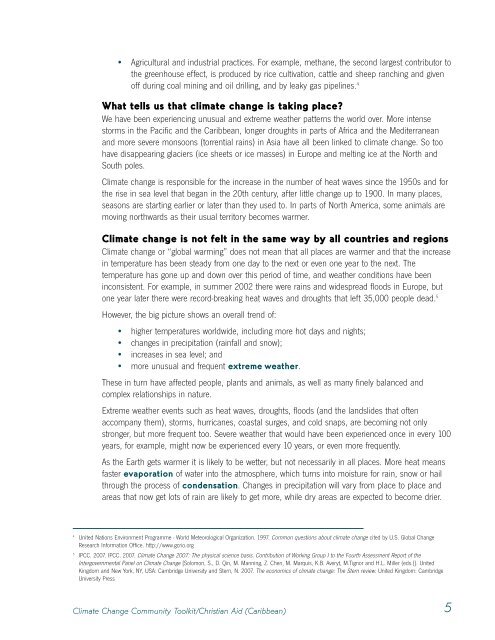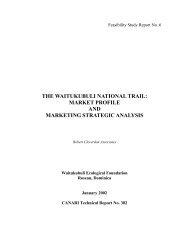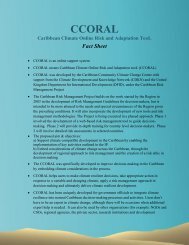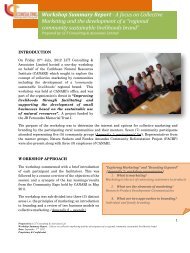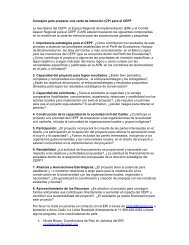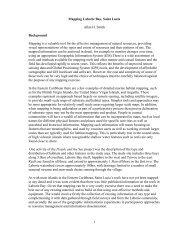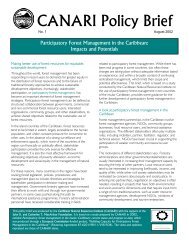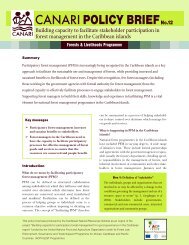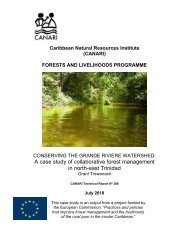Addressing Climate Change in the Caribbean: A Toolkit ... - CANARI
Addressing Climate Change in the Caribbean: A Toolkit ... - CANARI
Addressing Climate Change in the Caribbean: A Toolkit ... - CANARI
Create successful ePaper yourself
Turn your PDF publications into a flip-book with our unique Google optimized e-Paper software.
• Agricultural and <strong>in</strong>dustrial practices. For example, methane, <strong>the</strong> second largest contributor to<br />
<strong>the</strong> greenhouse effect, is produced by rice cultivation, cattle and sheep ranch<strong>in</strong>g and given<br />
off dur<strong>in</strong>g coal m<strong>in</strong><strong>in</strong>g and oil drill<strong>in</strong>g, and by leaky gas pipel<strong>in</strong>es. 4<br />
What tells us that climate change is tak<strong>in</strong>g place<br />
We have been experienc<strong>in</strong>g unusual and extreme wea<strong>the</strong>r patterns <strong>the</strong> world over. More <strong>in</strong>tense<br />
storms <strong>in</strong> <strong>the</strong> Pacific and <strong>the</strong> <strong>Caribbean</strong>, longer droughts <strong>in</strong> parts of Africa and <strong>the</strong> Mediterranean<br />
and more severe monsoons (torrential ra<strong>in</strong>s) <strong>in</strong> Asia have all been l<strong>in</strong>ked to climate change. So too<br />
have disappear<strong>in</strong>g glaciers (ice sheets or ice masses) <strong>in</strong> Europe and melt<strong>in</strong>g ice at <strong>the</strong> North and<br />
South poles.<br />
<strong>Climate</strong> change is responsible for <strong>the</strong> <strong>in</strong>crease <strong>in</strong> <strong>the</strong> number of heat waves s<strong>in</strong>ce <strong>the</strong> 1950s and for<br />
<strong>the</strong> rise <strong>in</strong> sea level that began <strong>in</strong> <strong>the</strong> 20th century, after little change up to 1900. In many places,<br />
seasons are start<strong>in</strong>g earlier or later than <strong>the</strong>y used to. In parts of North America, some animals are<br />
mov<strong>in</strong>g northwards as <strong>the</strong>ir usual territory becomes warmer.<br />
<strong>Climate</strong> change is not felt <strong>in</strong> <strong>the</strong> same way by all countries and regions<br />
<strong>Climate</strong> change or “global warm<strong>in</strong>g” does not mean that all places are warmer and that <strong>the</strong> <strong>in</strong>crease<br />
<strong>in</strong> temperature has been steady from one day to <strong>the</strong> next or even one year to <strong>the</strong> next. The<br />
temperature has gone up and down over this period of time, and wea<strong>the</strong>r conditions have been<br />
<strong>in</strong>consistent. For example, <strong>in</strong> summer 2002 <strong>the</strong>re were ra<strong>in</strong>s and widespread floods <strong>in</strong> Europe, but<br />
one year later <strong>the</strong>re were record-break<strong>in</strong>g heat waves and droughts that left 35,000 people dead. 5<br />
However, <strong>the</strong> big picture shows an overall trend of:<br />
• higher temperatures worldwide, <strong>in</strong>clud<strong>in</strong>g more hot days and nights;<br />
• changes <strong>in</strong> precipitation (ra<strong>in</strong>fall and snow);<br />
• <strong>in</strong>creases <strong>in</strong> sea level; and<br />
• more unusual and frequent extreme wea<strong>the</strong>r.<br />
These <strong>in</strong> turn have affected people, plants and animals, as well as many f<strong>in</strong>ely balanced and<br />
complex relationships <strong>in</strong> nature.<br />
Extreme wea<strong>the</strong>r events such as heat waves, droughts, floods (and <strong>the</strong> landslides that often<br />
accompany <strong>the</strong>m), storms, hurricanes, coastal surges, and cold snaps, are becom<strong>in</strong>g not only<br />
stronger, but more frequent too. Severe wea<strong>the</strong>r that would have been experienced once <strong>in</strong> every 100<br />
years, for example, might now be experienced every 10 years, or even more frequently.<br />
As <strong>the</strong> Earth gets warmer it is likely to be wetter, but not necessarily <strong>in</strong> all places. More heat means<br />
faster evaporation of water <strong>in</strong>to <strong>the</strong> atmosphere, which turns <strong>in</strong>to moisture for ra<strong>in</strong>, snow or hail<br />
through <strong>the</strong> process of condensation. <strong>Change</strong>s <strong>in</strong> precipitation will vary from place to place and<br />
areas that now get lots of ra<strong>in</strong> are likely to get more, while dry areas are expected to become drier.<br />
4<br />
United Nations Environment Programme - World Meteorological Organization. 1997. Common questions about climate change cited by U.S. Global <strong>Change</strong><br />
Research Information Office. http://www.gcrio.org<br />
5<br />
IPCC. 2007. IPCC. 2007. <strong>Climate</strong> <strong>Change</strong> 2007: The physical science basis. Contribution of Work<strong>in</strong>g Group I to <strong>the</strong> Fourth Assessment Report of <strong>the</strong><br />
Intergovernmental Panel on <strong>Climate</strong> <strong>Change</strong> [Solomon, S., D. Q<strong>in</strong>, M. Mann<strong>in</strong>g, Z. Chen, M. Marquis, K.B. Averyt, M.Tignor and H.L. Miller (eds.)]. United<br />
K<strong>in</strong>gdom and New York, NY, USA: Cambridge University and Stern, N. 2007. The economics of climate change: The Stern review. United K<strong>in</strong>gdom: Cambridge<br />
University Press<br />
<strong>Climate</strong> <strong>Change</strong> Community <strong>Toolkit</strong>/Christian Aid (<strong>Caribbean</strong>) 5


